During the spring season, it is traditional to observe Mercury, the planet closest to the Sun and therefore the most difficult to spot in the sky. This year, Mercury will be visible in the first half of the month. It is possible to locate the planet without the need for any optical instruments, as long as the sky is clear. Venus will also continue to shine brightly in the evenings. In addition to these two planets, Mars and Uranus can be spotted in the sky during April 2023. The remaining planets are obscured by the Sun’s proximity. Let’s take a closer look at the visibility conditions for each planet throughout the month.
April is anticipated to bring the most optimal evening visibility of Mercury in 2023. Throughout the first half of the month, the planet will be observable in the evenings, juxtaposed against the waning dawn.
In general, it is quite challenging to spot Mercury in the middle latitudes. To observe the planet with the naked eye, one must have precise knowledge of where and when to look. At the start of April, Mercury can be seen low above the horizon in the western sky during the evenings. The visibility lasts for approximately thirty minutes before the planet descends below the horizon. The search for Mercury should commence around forty-five minutes after sunset. During this period, there is a window of about twenty minutes to attempt to catch a glimpse of the planet amidst the still-illuminated sky.
Venus and Mercury in the April sky
You can use the brightness of Venus to help you locate Mercury in the sky. How? If you mentally draw a slanted line from Venus towards the brightest part of the dawn on the horizon, it will point you in the direction of Mercury, which will be positioned quite low above the horizon. While at the start of the month, Mercury’s brightness reaches -1.0 m, which is brighter than any star except Sirius, it still appears quite dim against the backdrop of the dawn. (The contrast with the dazzling Venus is especially noticeable!).
Of course, it’s important to have an unobstructed view of the horizon towards the west (buildings, trees, and mountains can easily block the planet) and clear of any clouds or haze.
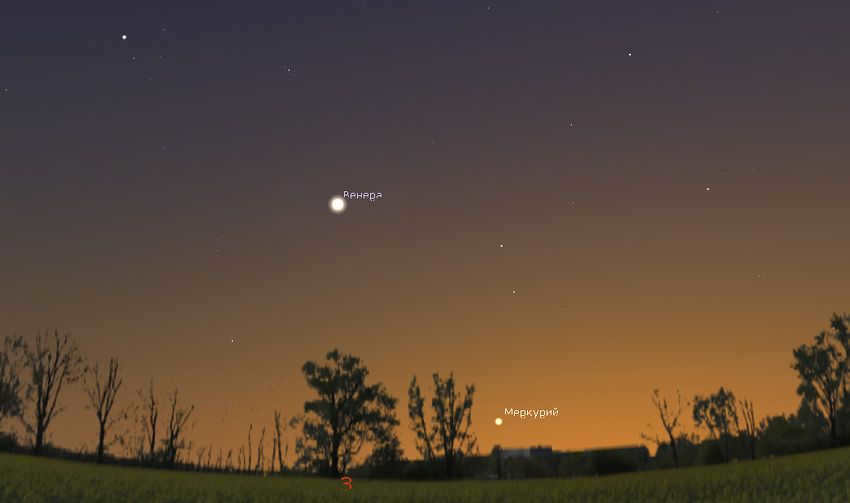
In the evening sky on April 1, 2023, about an hour after sunset, Venus and Mercury can be observed. This image depicts the view from the middle zone of Russia. Image source: Stellarium
The period from April 5 to 16 offers the most optimal circumstances for observing the nearest planet to the Sun. During this time frame, the visibility of Mercury in the evening sky will increase to one hour, with the planet being observable against a relatively dark background for about thirty minutes. The task of locating Mercury during this period will be significantly easier compared to the initial days of the month. It is worth noting that the conditions for observing the closest planet to the Sun will be more favorable the further south the observer is situated. For instance, in the Caucasus region, the planet will remain visible for a longer duration and at a higher position above the horizon compared to Moscow’s latitude, and similarly, in Moscow, it will be higher in the sky than in St. Petersburg.
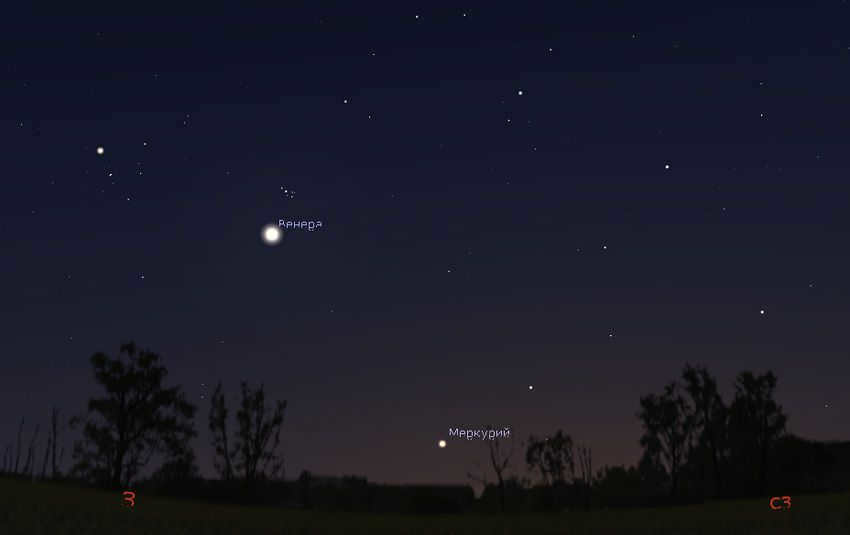
In the evening of April 9, Venus and Mercury can be seen 1.5 hours after sunset. The given picture is for the latitude of Moscow and Minsk. (Figure: Stellarium)
By April 12, the planet will reach its maximum eastern elongation, with an angular distance of 19.5° from the Sun in the sky. A few days later, around April 18 – 20, the planet will disappear in the rays of the evening dawn.
So, to observe Mercury:
- Begin observing about 45 minutes after sunset. From April 1 to April 5, you only have 30 minutes to locate the planet. From April 1 to April 15, allow 45 minutes to 1 hour.
- Look towards the west, where the evening dawn is.
- Keep an eye out for the planet a few degrees above the horizon.
- To find Mercury, use Venus as a guide.
Venus in April 2023
It goes without saying how much more dazzling and captivating the celestial canopy becomes when a radiant object like Venus emerges? During the first half of 2023, the planet will present itself as a stunning Evening Star. Appearing prior to sunset (have you ever had the chance to spot Venus in the daytime sky?), the planet will radiate brilliantly in the early twilight.
Venus has no contenders in the celestial sphere. On early evenings in early April, you will be able to compare the luminosity of Venus and Sirius, the most brilliant star in the nocturnal expanse. You will undoubtedly be astounded by the superior brightness and potency of Venus!
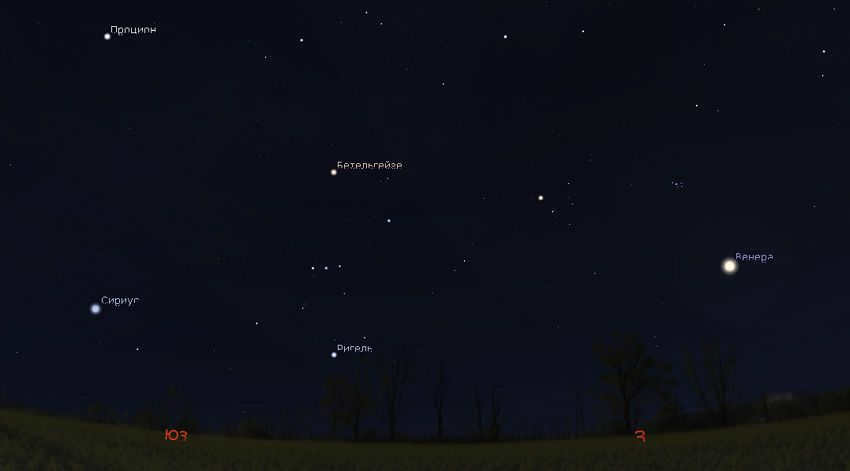
In the evening sky of the first ten days of April 2023, Venus and Sirius can be seen. Image: Stellarium
The Evening Star, also known as Venus, is easily visible in the sky unless you happen to look for it at the wrong time. Venus is visible for approximately 3 hours in the evening before it sets below the horizon. The planet can be observed in the western part of the sky where the Sun has set.
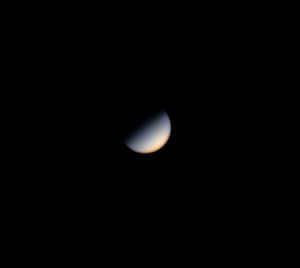
At the conclusion of April 2023, if observed through a telescope, this is approximately the appearance of Venus. A special filter was utilized to capture this image, resulting in the planet’s light being diminished and its color taking on a bluish-orange hue. In actuality, the semi-disk of Venus will appear brilliantly white. Photo credit: V. Petkov
During the month, the brightness of Venus gradually increases from -4.00 magnitude to -4.15 magnitude. It also appears larger when observed through a telescope, with its angular size growing from 14 to 17 seconds of arc. It is evident that the planet is moving closer to Earth in space. Additionally, the phase of Venus will change over the course of April. At the beginning of the month, the planet will resemble a phase between the first quarter and full moon, but by the end of the month, the phase will decrease to the first quarter. When observed through a telescope, Venus will appear as a small half-disc of brilliant white color. However, it is unlikely that you will be able to discern any specific details on the planet’s surface.
On the other hand, observing Venus with the naked eye can be a truly enjoyable experience!
One other planet that can be easily seen in the sky during April is Mars. This red planet can be found in the Gemini constellation, which is located within the Winter Circle and above the notable Orion constellation. Mars is best observed during the evening and the first half of the night. To locate the planet, follow these steps:
- Wait for about 1 to 1.5 hours after sunset, when twilight has darkened, and face southwest (which is the large portion of the sky to the left of Venus).
- The first thing that will catch your attention is likely the bright star Sirius, which is low on the horizon. Sirius appears to twinkle and shimmer with various colors.
- To the right of Sirius (towards Venus) is the stunning hourglass-shaped constellation Orion. The three bright stars in a row are particularly striking and are known as Orion’s Belt.
- Mars is positioned above the Orion constellation, soaring high above the horizon. While the planet appears dimmer than Sirius, it shares a similar level of brightness with the other brilliant stars in this section of the celestial sphere.
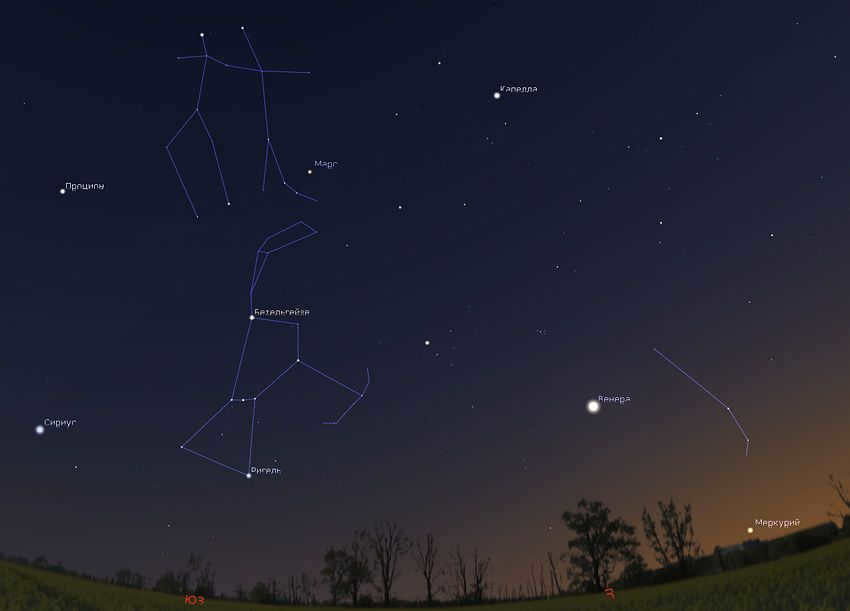
In April 2023, Mars can be seen in the evening sky in the Gemini constellation, positioned above the Orion constellation. Both constellations are clearly labeled in the provided image. This information is based on the data from Stellarium.
When observing Mars, one can easily notice its distinctive reddish color, which sets it apart from the nearby red stars Betelgeuse and Aldebaran. However, the planet’s brightness is diminishing rapidly. At the beginning of April, Mars has a brightness of 0.94 m, but by the end of the month, it decreases to 1.28 m. The human eye may have more difficulty distinguishing the planet at this level of brightness.
The size of Mars also decreases, going from 6.4″ in early April to 5.4″ by the end. When viewed with a standard telescope, the planet appears as a small orange dot. To see the most detail on its surface, you’ll need a telescope with a lens that is at least 100mm in diameter and a magnification of 120x or higher.
In general, the conditions for observing Mars are getting worse. The planet’s visibility in the evening decreases from 6 hours at the beginning of April to 4 hours at the end. In a couple of months, Mars will become as faint as a typical star and will no longer be visible in the evening. We will have to wait almost two years for the next bright appearance of Mars.
Jupiter in April 2023
In late March, the visibility of the largest planet in our solar system during the evening hours came to an end. Throughout the entirety of April, Jupiter will remain hidden from view as it is positioned very close to the Sun in the sky. On April 12th, which is also known as the Day of Cosmonautics, Jupiter will align with the Sun, transitioning from the evening sky to the morning sky. It is anticipated that Jupiter will make its first appearance in the morning sky around mid-June.
By the end of January 2023, the regular cycle of visibility of the celestial body known as Saturn came to a close. Subsequently, on February 16, it entered into a state of conjunction with the Sun. This colossal planet adorned with rings has now transitioned into the morning sky, although it is still in such proximity to the Sun that it becomes obscured by its radiant rays. The month of April will be marked by the continued invisibility of Saturn. However, it is anticipated that in the latter part of May 2023, the planet will once again become visible in the morning sky.
Uranus and Neptune in April 2023
The distant celestial bodies Uranus and Neptune may not capture the attention of aspiring stargazers due to their lack of visibility to the naked eye. However, individuals with exceptional eyesight may be able to catch a glimpse of Uranus under optimal conditions in a dark and unobstructed suburban sky. To locate these planets, one must possess the skills to navigate the vast expanse of the starry sky, utilize a telescope, and consult star charts.
Nevertheless, it is still possible to occasionally spot these planets with minimal effort. For instance, if there happens to be a prominent Moon or another luminous planet in close proximity to Uranus and Neptune, they can serve as helpful guides to locate the more faint celestial bodies.
What is the method for locating Uranus in early April 2023?
During the initial days of April 2023, there is a unique celestial alignment. On the 1st and 2nd, Uranus can be found in close proximity to the bright planet Venus. To locate Uranus, simply aim your telescope at Venus and then adjust the telescope’s angle downwards by a few degrees. It is recommended to use the lowest possible magnification setting in order to have a wider field of view. (Once Uranus has been successfully located, you can increase the magnification to observe the planet in greater detail.)
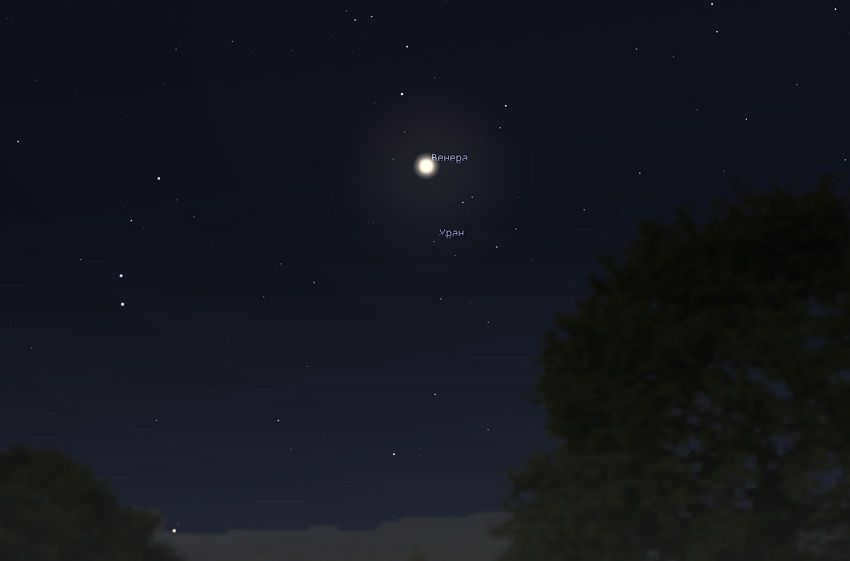
In the evening of April 1, 2023, Venus and Uranus can be seen in the sky. This is indicated by the proximity of Uranus to Venus, which suggests that Uranus’ visibility in the evening is coming to an end. Although Uranus is moving in a straight line against the stars from west to east, its motion is much slower than that of the Sun, which is also moving in the same direction.
By April 10, Uranus will become almost impossible to observe at the latitude of St. Petersburg, as it will be hidden in the rays of the evening dawn. On April 20, the planet will completely disappear in southern Russia.
Is Neptune the most distant planet?
The visibility of Neptune at night ended in late February. On March 16, the planet aligned with the Sun. Currently, Neptune is officially in the morning sky, rising just before sunrise in the eastern direction. However, due to the bright dawn, the planet is not visible as it emerges. The start of Neptune’s morning visibility will not occur until June. However, considering the short nights during this season in the middle part of Russia, it is safe to postpone the observation of the planet until August if you are in Moscow or further north.
Summaries of Celestial Phenomena
In April 2023, the evening sky offers a captivating display of celestial bodies, with the prominent presence of Mars, Mercury, and Venus. During the first two decades of the month, Mercury graces the horizon for approximately an hour, blending harmoniously with the evening dawn. Venus, on the other hand, remains visible for a generous duration of three hours. As for Mars, its brilliant presence enchants the sky for six hours at the beginning of April and four hours towards the end of the month.
Additionally, Uranus, another captivating planet, can be observed in the evening sky during the first half of April, positioned not far from Venus. Regrettably, the remaining planets remain elusive and invisible during this period.
The Lyrids meteor shower, known for its beautiful name, is the initial celestial event of spring. It earned its name due to the fact that its meteors appear to originate from the Lyra constellation. This year, the peak of the Lyrid meteor shower is set to occur on April 22, with an expected rate of up to 18 meteors per hour. Experts predict that the moon, which will be in the new moon phase, will not obstruct the observation of the meteors.
Take advantage of the first astronomical phenomenon of spring, where you will have numerous opportunities to make wishes upon shooting stars – all in this article from REN TV.
What are meteors
A meteor is a small cosmic object (a fragment of a comet or asteroid) that enters the Earth’s atmosphere at a high speed (up to 80 kilometers per second) and burns up, creating a bright streak.
Occasionally, the glow of a meteor is so intense that it can outshine even the brightest stars and planets, and these particularly bright meteors are known as bolides. Their bursts of light are hard to overlook, as they can briefly transform a nighttime landscape into daylight.
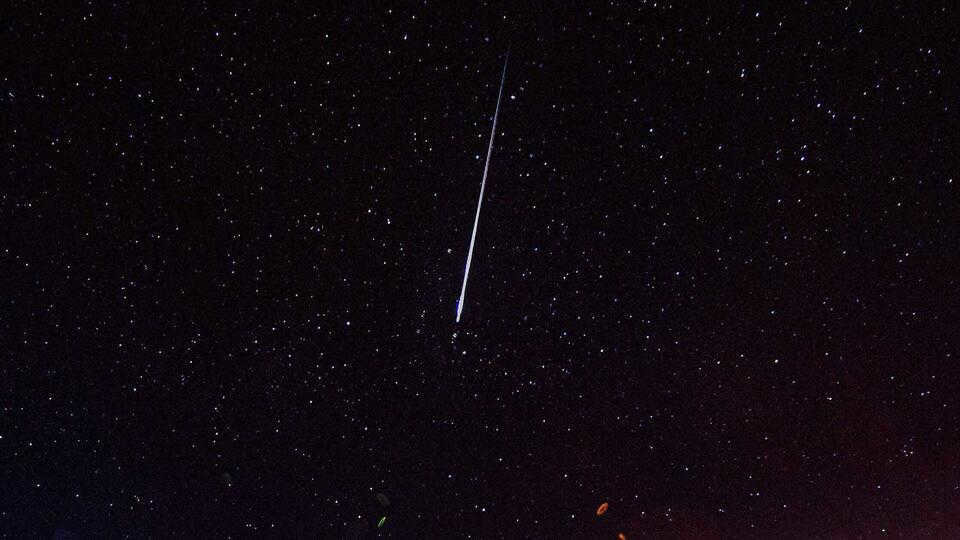
A falling bolide is a cosmic particle of considerable size that appears as a bright glowing sphere with a lengthy tail, visible at night and dark during the day. The sounds emitted by a bolide as it descends and combusts can be likened to a mix of rumbling, buzzing, humming, and whistling. Furthermore, the descent of large bolides may disrupt radio communications. The meteoric body of a bolide often descends to Earth and transforms into a meteorite.
It is crucial to grasp that a meteor is a phenomenon rather than a tangible object; in reality, it is a luminous trail left behind by a falling body.
The grouping of meteors into meteor streams occurs annually, during a specific time of year, on a particular side of the sky. This phenomenon is a result of the continuous movement of “meteor swarms” throughout the solar system. These swarms occasionally intersect with Earth’s orbit and enter the atmosphere.
These meteor streams are formed from the remnants of comets or asteroids that have been destroyed while passing near the Sun, causing them to melt.
There is a concept known as the radiant meteor stream, which refers to the point from which the meteors appear to originate. This is due to the close proximity of cosmic matter particles as they enter Earth’s atmosphere. Currently, there have been 64 permanent meteor streams identified by scientists, with an additional 300 awaiting registration.
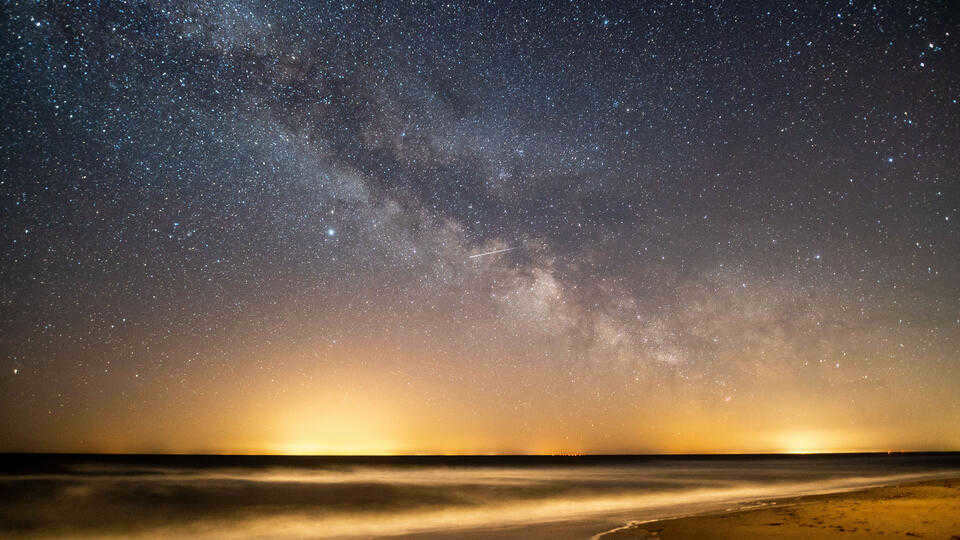
When and Where to Witness the Lyrid Meteor Stream
Each year, the initial spring meteor shower can be observed from April 16th to April 25th. The peak of the Lyrid meteor shower in 2023 will occur on the night of April 21st to April 22nd.
The maximum activity will happen on April 22nd at 18:04 World Time or 21:04 Moscow time. At this time, the radiant of the stream will be located at coordinates: alpha = 271°, delta = +34°.
How to Experience the Lyrid Meteor Shower
When viewing the night sky from Earth, meteors appear as luminous streaks that captivate our imagination. The Lyrid meteor shower offers a breathtaking spectacle for stargazers around the world, with residents of the Northern Hemisphere in for a particularly vibrant and colorful display.
The intensity of the meteor shower varies from year to year, and in 2023, the Lyrids are expected to showcase up to 18 meteors per hour. For optimal viewing, it is recommended to observe the Lyrids after 3 a.m. and before dawn, when the Moon is in its first quarter phase and will set below the horizon. This absence of moonlight allows the fainter meteors to shine brightly against the dark sky.
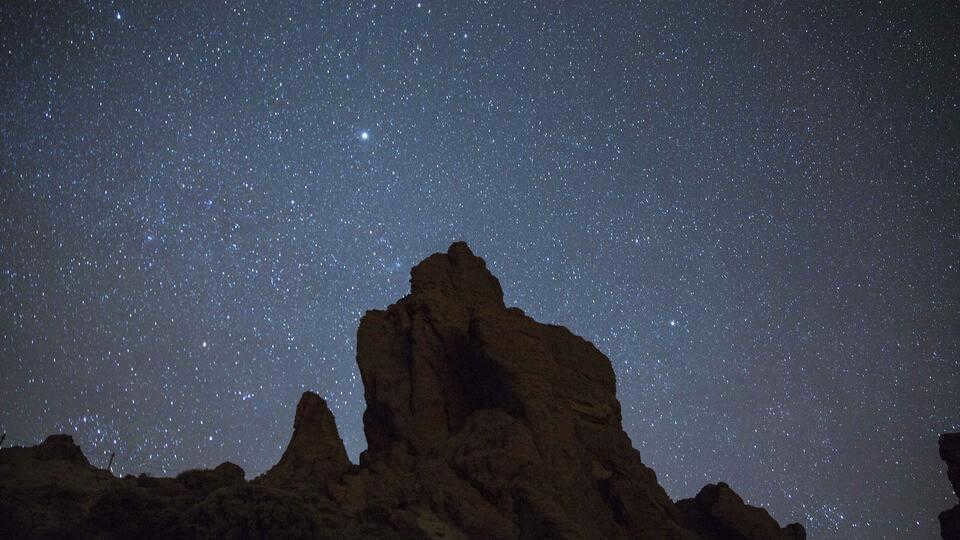
“To observe the Lyrids meteor shower, it is recommended to direct your gaze towards the radiant – the point in the sky from which the meteors will appear to originate. In the case of the Lyrids, this radiant is located in the vicinity of the star Vega, which will become visible on the eastern horizon around midnight,” explains Oleg Kashin, an expert from the Bolshoi Novosibirsk Planetarium.
Vega, which is the brightest star in the Lyra constellation, can be easily located. It is part of the summer-autumn triangle, a group of three stars that can still be seen even in areas with significant light pollution. Vega is positioned around eight degrees northeast of the Lyrids’ radiant.
For optimal viewing of the Lyrid meteor shower, astronomers recommend finding a location that is far away from any sources of light. Once you have found a suitable spot, tilt your head towards the constellation Lyra. However, instead of focusing directly on the radiant, it is advised to look just slightly away from this point. By doing so, you will be able to observe the brightest and longest meteors.
The Origins of the Lyrid Meteor Shower
The Lyrid meteor shower is one of the oldest known meteor streams, with records of its observation dating back over 2,500 years. The earliest documented mention of the Lyrids comes from China, where it was reported that “the stars fell like rain” in the spring of 687 BC.
Another notable occurrence of the Lyrid meteor shower took place in 1803, when a meteor storm passed over the east coast of the United States. During this event, the number of falling meteors reached an astonishing 700 per hour.
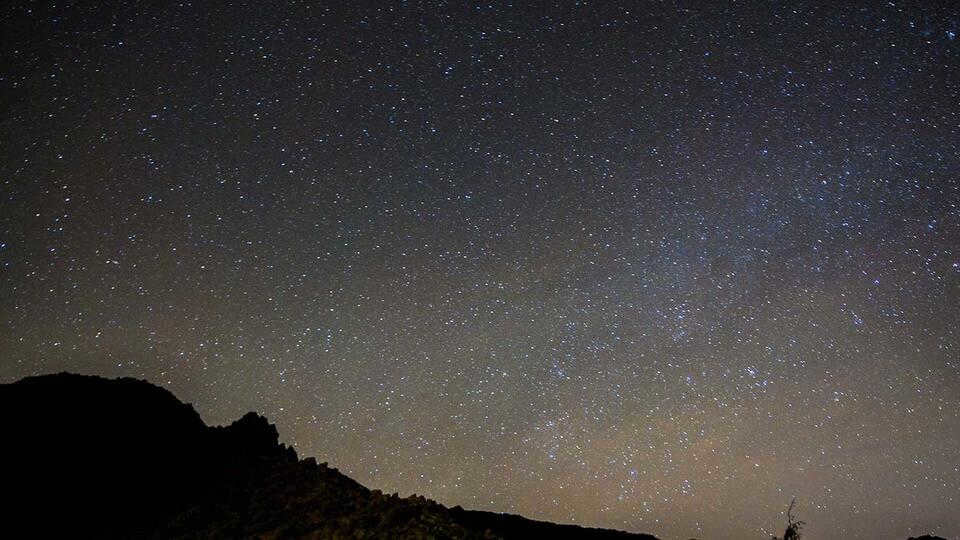
Over time, the Lyrid meteor shower has diminished in brightness, but it continues to captivate astronomers with unexpected displays.
The Lyrid meteor shower surprised experts once again in 1922, when the Earth experienced a magnificent meteor storm with a rate of 1800 meteors per hour. In 1982, Earthlings were treated to an impressive spectacle of 100 meteors per hour. The most recent peak activity of the Lyrids was observed in 1985, with a rate of 200 meteors per hour.
Astronomers are still unable to explain the sporadic bursts of intense activity or predict the future intensity of the Lyrid meteor shower.
During the second half of April each year, the Earth traverses a cloud of dust that originated from the tail of Comet Thatcher, serving as the origin of the Lirida meteors. The particles and small rocks left behind by the comet enter the atmosphere at an altitude ranging from 100 to 120 kilometers. They descend rapidly, travelling at a speed of 49 kilometers per second, and disintegrate into bright flashes.
The last time Comet Thatcher, which completes a full orbit around the Sun once every 415 years, entered the inner region of the solar system was in 1861 – during that time, it contributed slightly to the meteor shower. Its next appearance is predicted to occur in 2276.
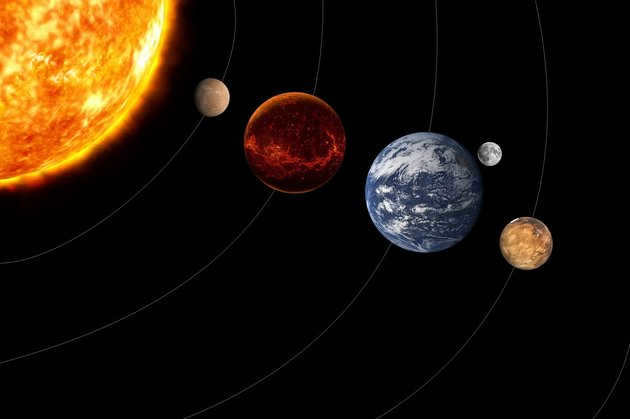
An extraordinary celestial event is set to take place on April 11, 2023 – a magnificent procession of planets. Mercury, Uranus, Venus, and Mars will align perfectly in the night sky, creating a spellbinding spectacle. While some may associate such occurrences with ill omens and calamity, astronomers refer to this phenomenon as “planetary convergence.” During this event, these celestial bodies will appear to be in close proximity to one another when observed from Earth. The size of these planetary parades can vary, ranging from small gatherings of three or four planets to grand spectacles involving more than five planets. A truly exceptional parade took place on July 4, 2020, involving all nine planets in the solar system. Unfortunately, we will have to wait until 2161 for the next complete parade of planets.
What is the scheduled date for the 2023 planetary parade?
On the evening of April 11, 2023, a unique celestial event will occur as Mercury, Uranus, Venus, and Mars align in the sky just after sunset. This rare occurrence will be visible within a small 35-degree sector of the sky. While Mars and Venus will be easily discernible with the naked eye, locating Mercury and Uranus will require the use of powerful binoculars. To witness the precise moment when all four planets align, one must patiently wait for Mercury to rise above the horizon in the constellation of Aries on the night of April 11. This will be the optimal time to observe Mercury, as it will be at its farthest distance from the Sun in the sky. The brightest of the four celestial bodies, Venus, will be shining brightly in the constellation of Taurus. Meanwhile, red-hued Mars will be visible just above Venus, in the constellation of Gemini, in the western sky. The fainter planet Uranus can only be spotted with the aid of binoculars. It can be found positioned between Mercury and Venus in the constellation of Aries. For the most accurate information regarding the ideal time to view this planetary alignment and the exact positions of Venus, Mercury, Mars, and Uranus in the sky, it is recommended to utilize popular astronomy applications such as Sky Tonight or Star Walk 2.
What are the perils of a planetary procession?
The concept of planetary parades took on a foreboding hue following the release of the scientific tome “The Jupiter Effect” in 1974, which posited a connection between cataclysmic earthquakes and a procession of planets, purportedly resulting in potent tidal forces. This notion was later debunked, but had already managed to permeate the general public’s consciousness.
According to calculations, parades of planets do not have a significant gravitational impact on Earth – this implies that such events cannot trigger an earthquake or a major flood. An example of this is Jupiter, which is 26 thousand times heavier than the Moon. However, even during a close encounter when the distance between Earth and the gas giant is at its minimum, the gravitational effect of Jupiter on our planet is approximately 103 times weaker than that of the Moon. This is because the gravitational field potential is inversely proportional to the square of the distance. Even if all the planets in the solar system align with Earth, the combined gravitational effect would be minuscule. Therefore, there is no need to be concerned about parades of planets.
A thrilling celestial phenomenon awaits avid stargazers in the upcoming days: just after dusk, a remarkable opportunity will present itself to witness the convergence of the five planets of our solar system in a single section of the heavens, perfectly aligned in a straight line. “Hitech” provides you with valuable insights on how to get ready for this extraordinary event and where to find the ideal vantage points for observing this planetary alignment.
Check out "Hitech" in
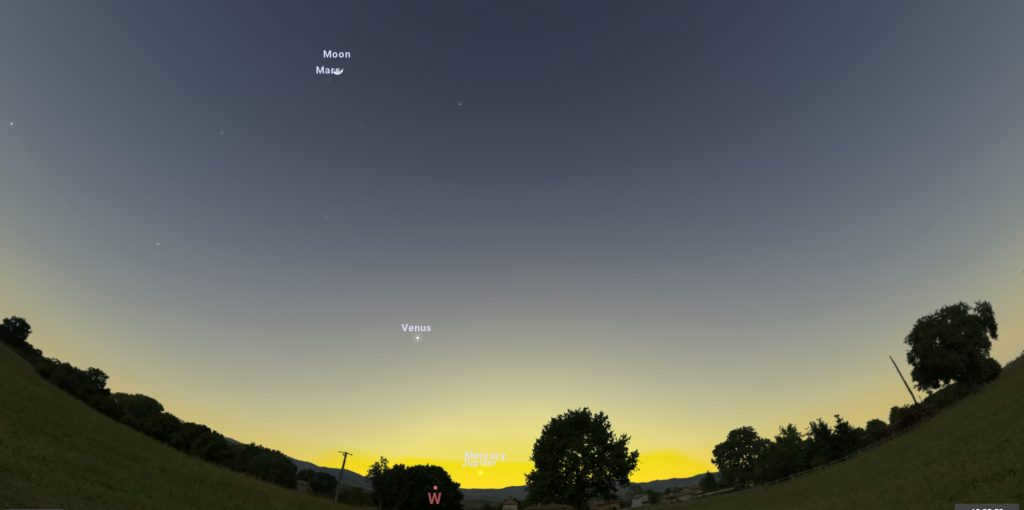
In the final days of March 2023, astronomy enthusiasts will have the opportunity to witness a celestial spectacle known as the parade of planets. Jupiter, Mercury, Venus, Uranus, and Mars will all grace the night sky simultaneously. On the evening of March 28, weather permitting, these planets will align in a small section of the sky, creating a mesmerizing display. While the peak of this event will occur on that particular night, the gradual alignment of the planets will be visible a few days before and after. However, it’s worth noting that after March 28, Jupiter may become obscured by the radiant glow of the setting sun, making it advantageous to select one of the preceding days for observation.
- mini alignment of planets (3 planets);
- minor parade of planets (4 planets);
- big parade of planets (5 or 6 planets);
- complete alignment of planets (all planets in the solar system).
An entire alignment of planets is an incredibly uncommon event. It was last observed in 1982, and the next occurrence is not expected until 2161.
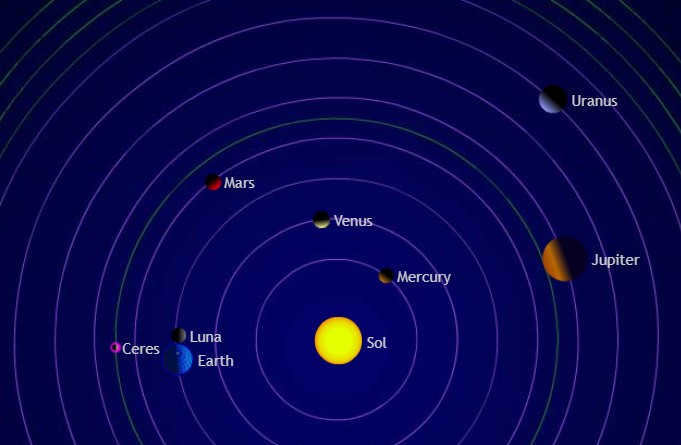
Tips for preparation and where to witness the event?
Certain planets emit enough light to be visible to the naked eye, even in areas with high levels of urban lighting. For instance, Venus, one of the most radiant celestial bodies besides the Sun and Moon, will be the easiest to spot. However, other planets may prove to be more challenging to observe.
Therefore, astronomers recommend venturing out of urban areas for optimal stargazing, where the glare from streetlights does not hinder the enjoyment of the night sky. Additionally, it is important to have an unobstructed view of the western horizon for observation.
Mars and Venus will reach a sufficient altitude above the horizon, while Jupiter and Mercury will only become visible shortly after sunset near the ground. As a result, the presence of mountains, buildings, or forests may hinder observations. Ideally, being along the West-facing coastline will provide an unobstructed view (aside from any potential weather conditions).
Mars and Venus will be easily visible to the naked eye, but for a more detailed observation of the shimmering Mercury and faint Jupiter, it is recommended to use binoculars or a telescope. Additionally, Uranus is always beyond the range of naked-eye visibility, so optical magnification is necessary to observe all five planets.
Remember to prioritize safety: since Mercury and Jupiter are located very close to the sunset point, caution should be exercised when using optical instruments after the Sun has fully set below the horizon.
When and where to search?
Right after the Sun goes down, direct your gaze towards the western horizon. Just above the horizon, where the Sun has recently disappeared, you will witness the presence of two planets: Jupiter and Mercury. These celestial bodies will emit a remarkable amount of light, with Mercury shining at a magnitude of -1.4, a mere fraction less bright than Sirius, the most luminous star in our firmament. Jupiter, on the other hand, will dazzle even more intensely, boasting a stellar magnitude of -2.1, which is twice the luminosity of Mercury.
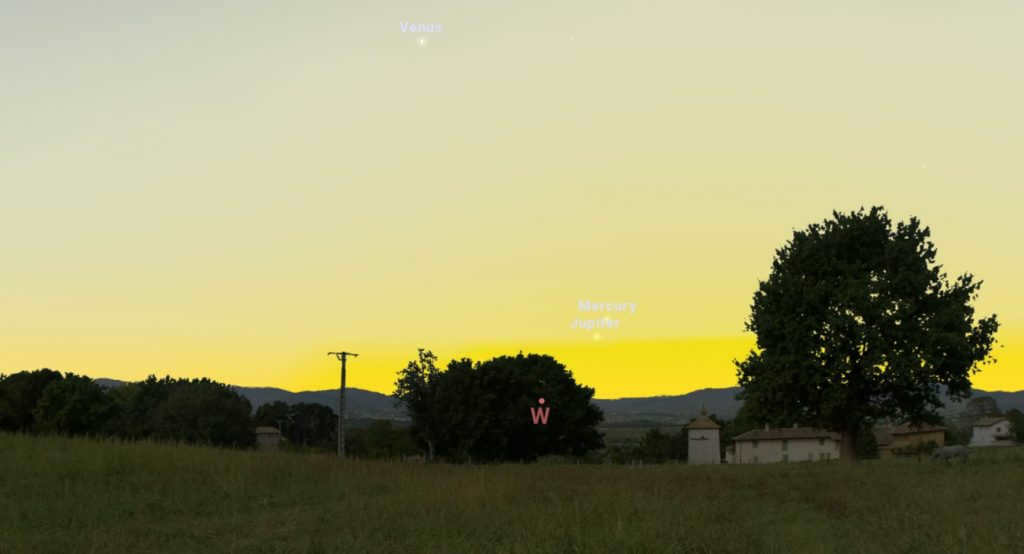
Venus, the most luminous among the five planets, is conveniently recognizable in the celestial expanse. One can locate it by using the constellation of Aries as a guidepost. In the night sky, Venus lies along an imaginary trajectory that can be traced from Jupiter and Mercury towards the Moon.
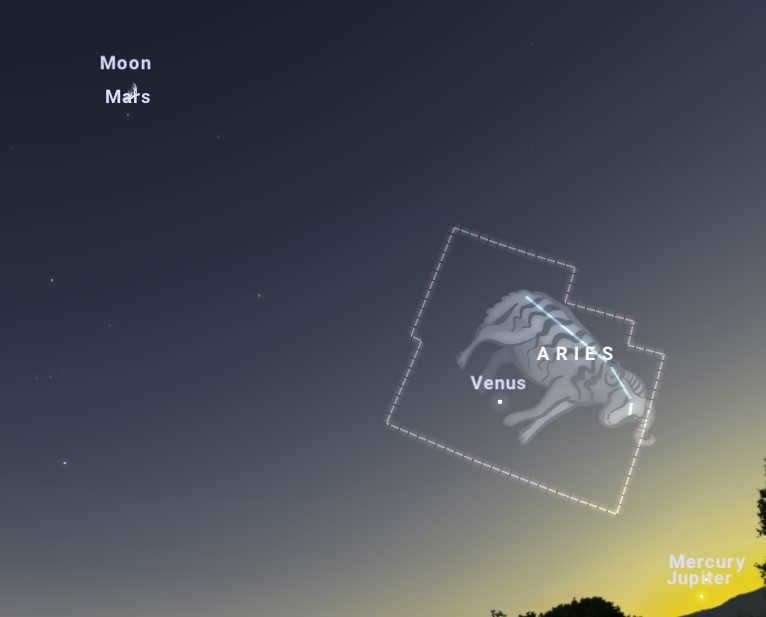
If you employ binoculars in close proximity to Venus, you will have the opportunity to observe a dim Uranus. Seek out a faint star with a faint greenish tint. The optimal time to observe this celestial body is after the complete dissipation of the sunset, and when Jupiter and Mercury have disappeared below the horizon: this way, there will be a reduced amount of light in the atmosphere.
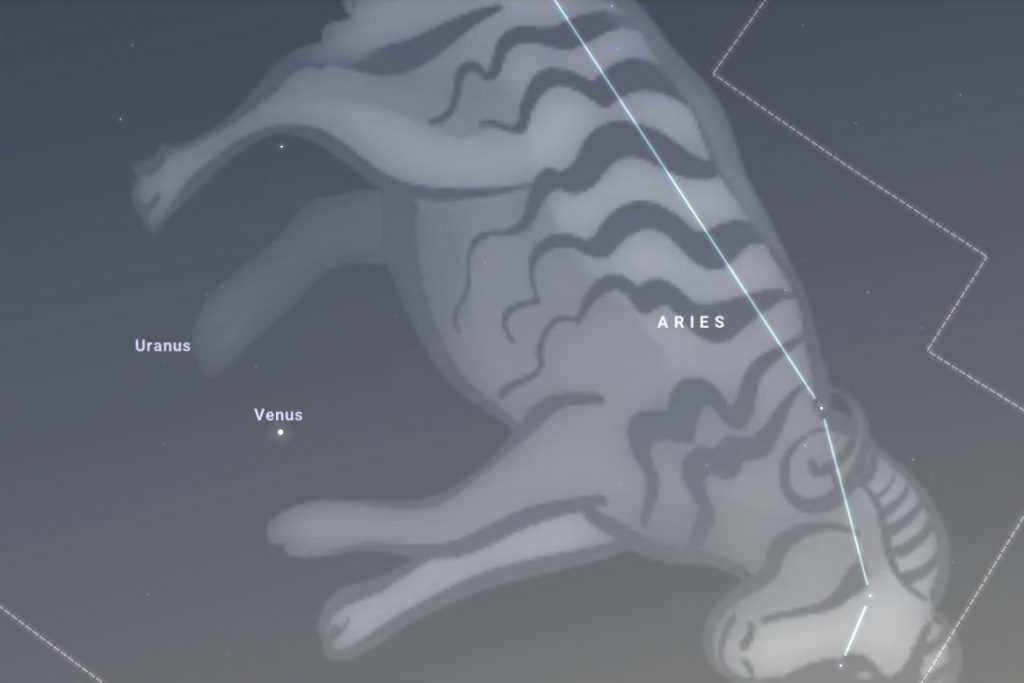
Lastly, Mars takes the fifth spot on the parade of planets. Locating it won’t be a challenge: this celestial body will emit a vivid red glow in the southwestern region of the sky near the Moon. Between March 25 and 27, you can find the planet slightly to the left of our natural satellite, and later on, right underneath it.
In the past, ancient astrologers assigned significant meanings to planetary parades and connected them with various natural disasters. Today, modern science debunks such notions, but it’s important to remember that this phenomenon presents an extra opportunity to marvel at the splendor of the night sky. If unfavorable weather conditions hinder your observations, fear not, as there will be another chance this year: the alignment of the less luminous five planets – Mercury, Uranus, Jupiter, Neptune, and Saturn – will be visible in mid-June.
More information can be found here:
Star Walk 2
Star Walk 2 provides a visual representation of the current location’s astronomical objects. It displays constellations, planets, the Moon, meteor showers, asteroids, comets, and deep space objects such as the Owl Nebula, the Minkowski Butterfly, and the globular cluster in the constellation Hercules. Additionally, it tracks satellites including SpaceX Starlink satellites, the International Space Station, and NASA’s Interstellar Frontier Explorer. The app also offers information on the rising and setting times of each object, helping users plan their stargazing observations. Furthermore, there is a separate “Today in the Sky” section that provides details on which objects will be visible on a specific day, allowing users to determine the best time to observe them.
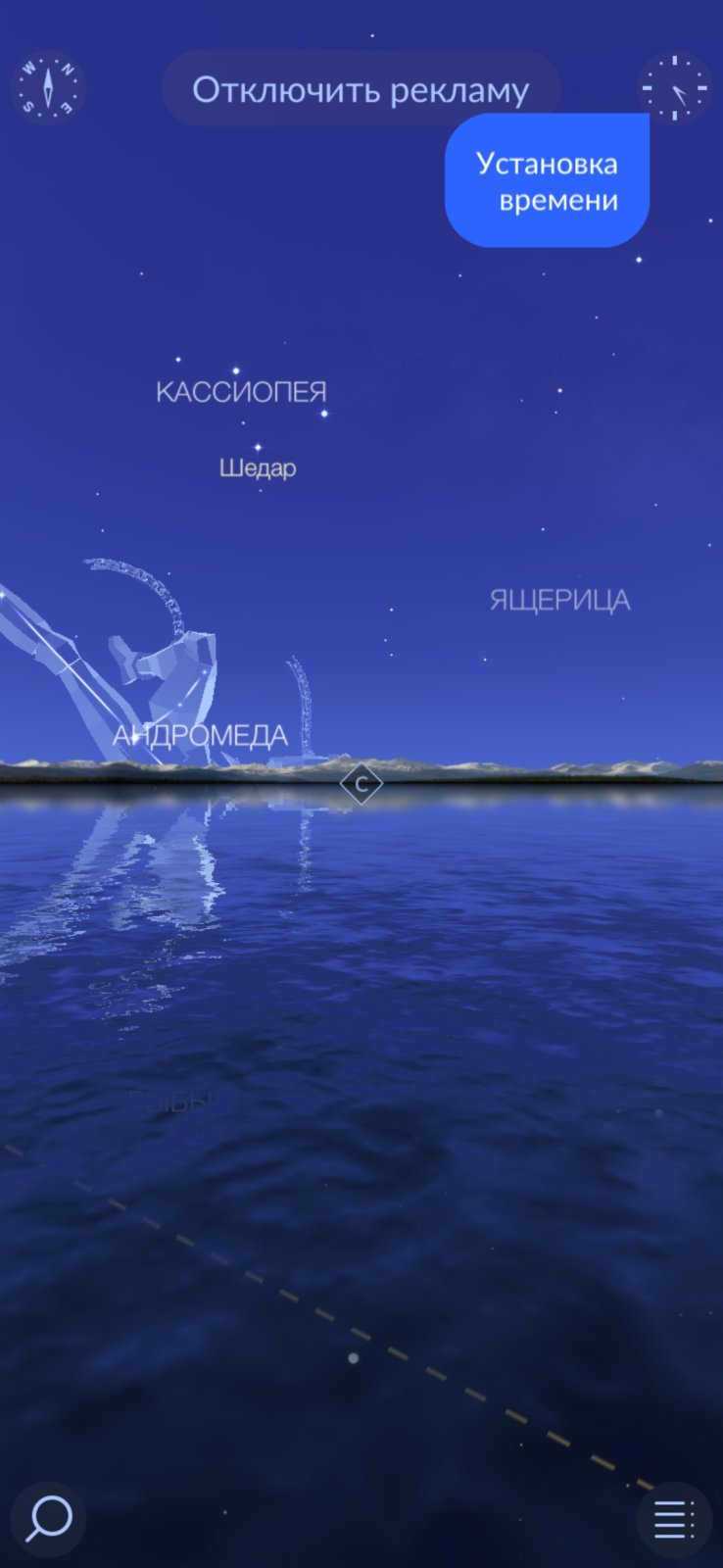
Star Walk 2 comes with default settings that use the current time and location of your device. However, you can choose to modify the time to a previous or future date and witness the appearance of the sky during that period. Additionally, you have the option to manually input coordinates or select from a list of preset cities to change your location. Another impressive feature of this app is augmented reality, which allows you to utilize your camera to identify celestial objects in the night sky. The app will then provide you with information and images of those objects. By upgrading to the premium version, you unlock even more extensive content and photos.
The menu of the app has been localized for Russian users, however, there are certain sections that require knowledge of English. Regrettably, this also includes the FAQ. Another disadvantage of Star Walk 2 is that users frequently experience crashes of the app. Additionally, if you opt not to purchase the premium version (which costs 459 rubles for the full price or 75 p. per month, but individual modules can be purchased separately), you will have to tolerate intrusive and irritating advertisements.
My Observations After Using a Smartphone with a 10,000 mAh Battery for a Week
Last week, I had the opportunity to test out the UMIDIGI Power 7 Max, a smartphone equipped with a powerful 10,000 mAh battery. This device impressed me with its exceptional battery life and performance.
Highlights from Saturday Coffee #261
Grab a hot cup of coffee and catch up on the latest news from this week. Exciting updates include new information about the upcoming iPhone 15, the merger of Yandex’s smart TV and smart speaker technologies, and the introduction of new car models in Russia.
Jetour arrives in Russia
In Moscow, the official unveiling of Jetour, a new Chinese car brand for our market, took place…
Review of the Creative Sound Blaster X5 external sound card
For gamers and music enthusiasts, the Creative Sound Blaster X5 is an external sound card that connects to PCs and consoles via USB and features dual DAC, proprietary X-AMP amplifier, Bluetooth, and a balanced 4.4mm headphone output!
Stellarium Mobile is an exceptional astronomy app for Android, offering an extensive collection of celestial objects. It provides detailed information on over 1.4 billion stars, 3 million galaxies and nebulae, 10,000 asteroids, and even the majority of visible artificial satellites. One of its standout features is its minimalist and user-friendly interface, ensuring an immersive experience of the night sky. The absence of cluttered buttons allows for a more enjoyable viewing experience. Moreover, the app includes a night mode option, enabling users to switch their phone’s screen to a red hue for easier usage in low-light conditions.
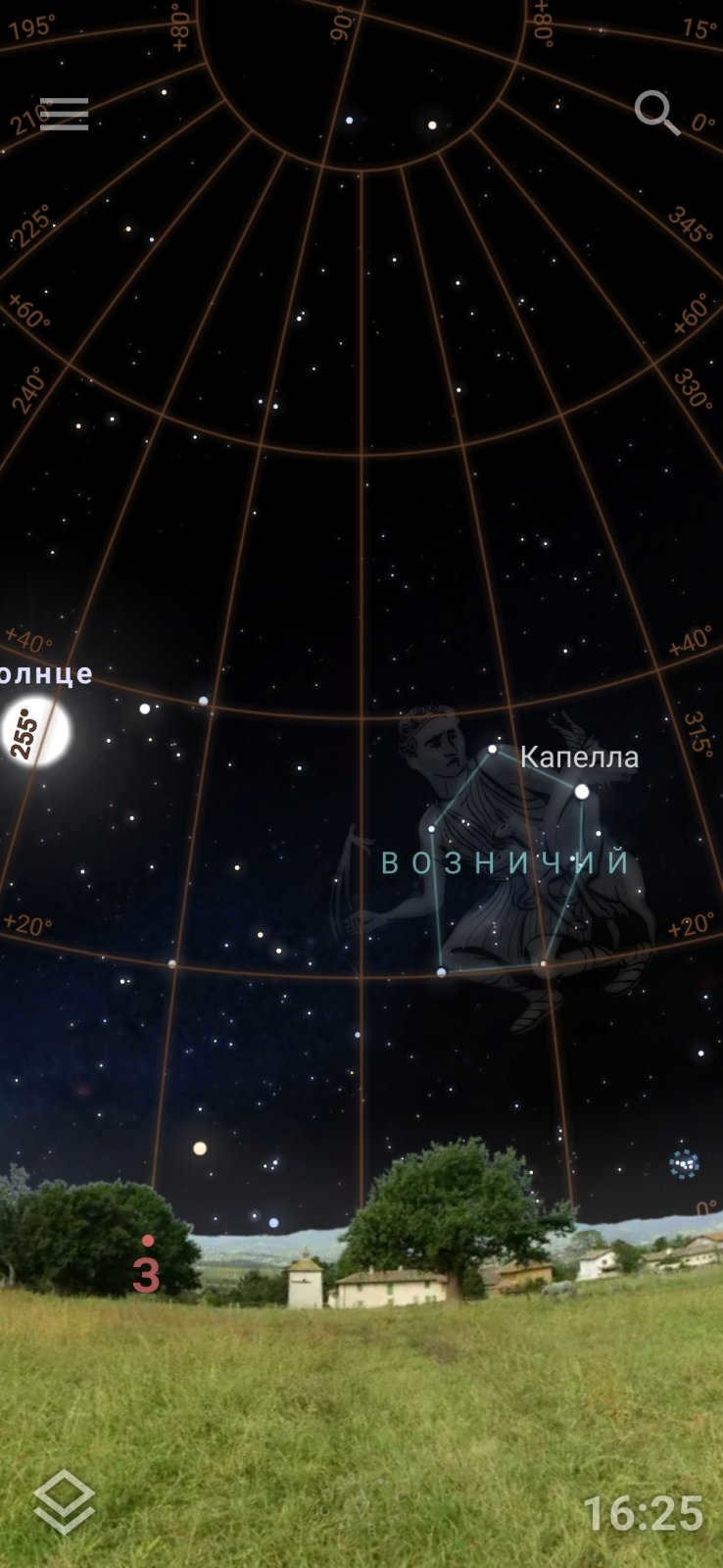
The Stellarium Mobile app utilizes the sensors on your device, allowing you to view celestial objects on your phone screen simply by pointing at a specific location. By tapping on the desired object, you can zoom in for a closer look and access detailed information about it. Additionally, you have the option to save frequently viewed objects to your favorites for quick and easy access. What sets this app apart from others in the field of astronomy is its ability to showcase the sky according to various astronomical traditions. In addition to the popular Western tradition, you can also explore the sky from the perspectives of Chinese, Inuit, and Scandinavian cultures.
Stellarium Mobile is available for free. However, if you wish to have the ability to control your telescope, view objects in 3D, and access the built-in astronomical calendar, you will need to upgrade to a premium account (449 rubles or 44 p/month). The app is completely localized in Russian, with detailed information about the observed celestial bodies.
Nightshift Stargazing
For those seeking a simpler approach to organizing their stargazing activities, Nightshift Stargazing offers a convenient solution. This application offers comprehensive information to enhance your nighttime astronomical adventures. It provides detailed weather reports for your specific location, including real-time and forecasted data, covering both local and Russian regions. This includes essential details such as cloud cover and precipitation, ensuring optimal visibility for your stargazing experience.
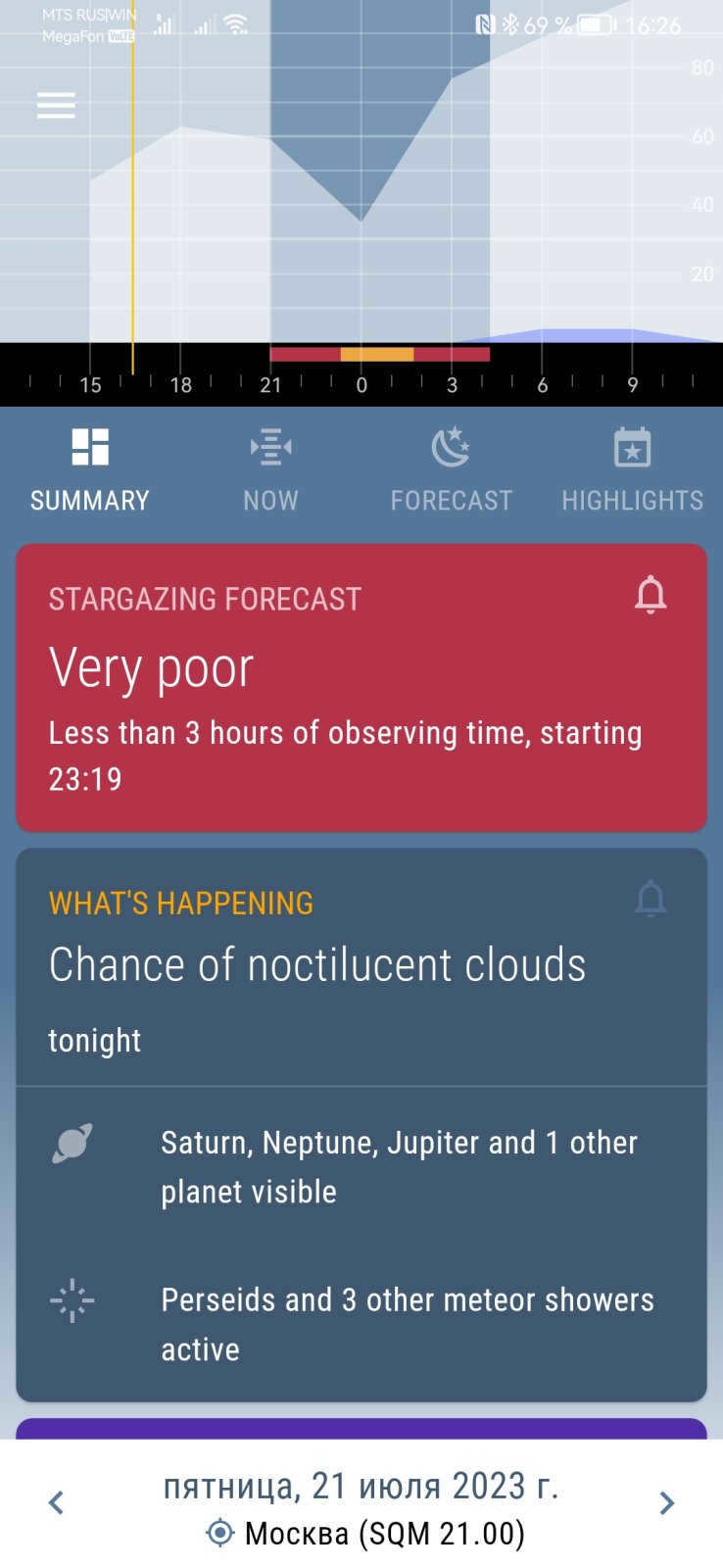
You can access information about the most fascinating astronomical events happening on a specific night. This includes important details such as the times of sunrise and sunset, the phase of the Moon, the duration of darkness, the visibility of various planets, the optimal observation times for each planet, and the presence of any active meteor streams.
If the application suggests that a particular night is ideal for stargazing, it will also provide a comprehensive list of captivating celestial objects to observe, along with the best times to view them and the recommended equipment (such as the naked eye, binoculars, or a telescope). However, if the app indicates that stargazing is not feasible, you can set up notifications to receive updates when conditions change.
You have the opportunity to observe any of the remaining seven planets in the solar system or one of the 15,000 objects in deep space that are included in the app’s extensive database. Nightshift Stargazing provides you with information about the specific days and hours when you can view the object you are interested in, as well as details about its sunrise and sunset times. Additionally, the app recommends the best equipment for optimal observation.
This app is completely free and does not include any advertisements. However, if you would like to support the creator, you have the option to sign up for a 3-month subscription ranging from 69 to 1,399 rubles. The app is available exclusively in English.
Heavens-Above
With its primary focus on tracking visible and radio satellites, Heavens-Above offers a unique experience for those interested in observing man-made objects rather than celestial bodies. The app boasts three main tabs on its toolbar: “Sky Map,” “Orbit,” and “Info.”

The Sky Map tab is an interactive map that displays the celestial bodies visible in the sky at your location. It provides information on the names of planets and constellations that can be observed when looking up. By selecting a satellite from the sidebar, its trajectory will be displayed on the star map as well. To accurately determine the position of planets and satellites, simply point your smartphone towards the sky and the pointer on the map will adjust accordingly. Continue adjusting until you locate the specific object of interest and determine its precise location.
You have the option to utilize the application for free, however, to eliminate the advertisements, you will need to install the Pro version (220.9 rubles). The menu is in Russian, but the prompts are presented as Reddit links, so having a good grasp of English will be beneficial.
NASA and Roscosmos
Space agencies also offer their own applications, which can be intriguing if you have an interest in astronomy. Both the American and Russian agencies have their respective applications, which share some similarities but also have notable differences. NASA’s application goes beyond the typical astronomy app that instantly displays a view of the night sky. It includes a wide range of NASA content, including official photos, videos, stories, news, and other relevant material. It’s important to note that all of this content is exclusively in English.
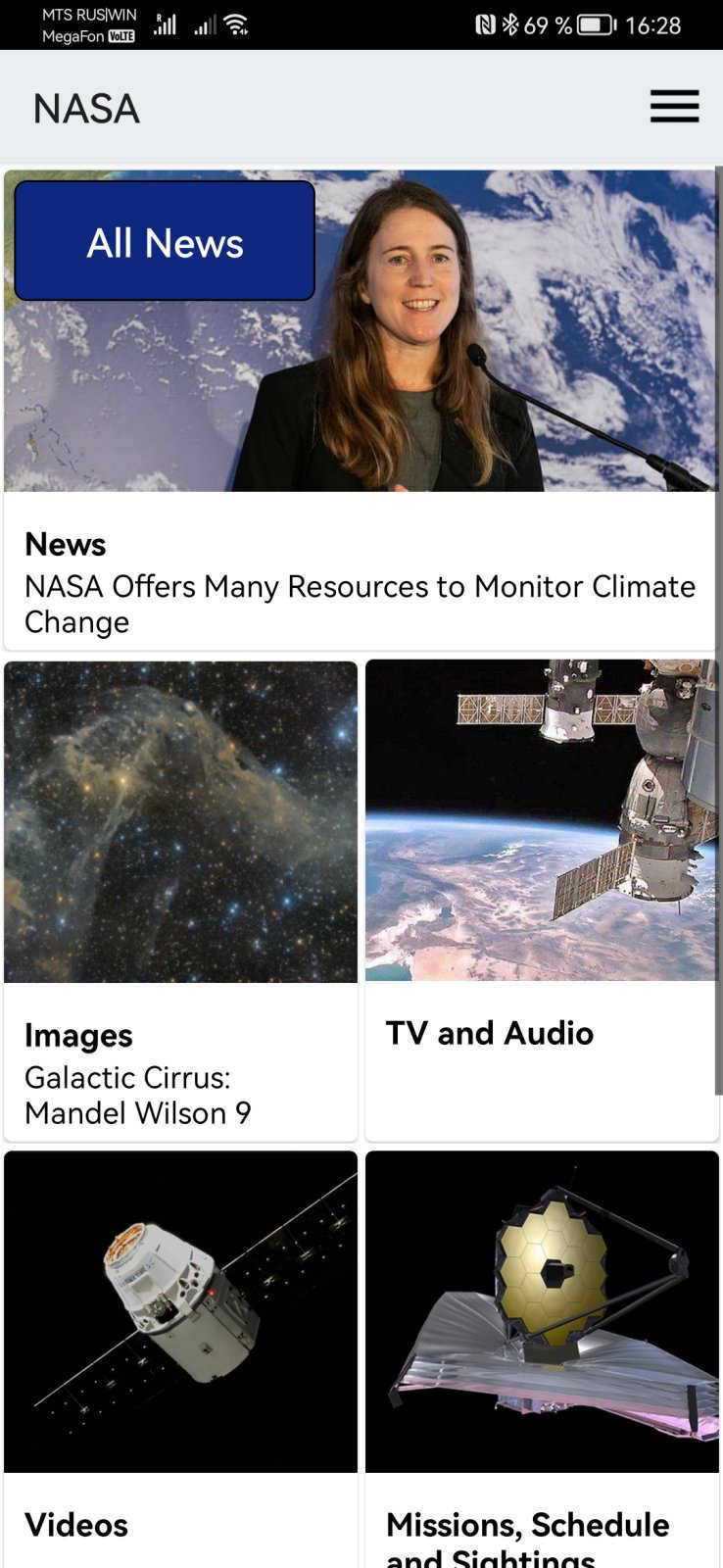
In this completely free application, you will find seven different categories. One of them is the “News” section, where you can read the most recent news and articles from the government space agency. Another category is the “Tweets” section, which displays the agency’s tweets. The “Missions, Schedules and Observations” section provides updated information on upcoming and ongoing NASA programs and missions. One of the highlights of this section is the ISS tab, which includes a feature called “Map”. This feature allows you to track the International Space Station and schedule upcoming observations based on your location.
Within the TV and Audio category, you have the opportunity to view live broadcasts from NASA TV and streaming video from the International Space Station (ISS). Additionally, you can listen to NASA’s podcast, NASAcast. For enhanced video quality, make your way to the Videos section, where you will discover over 14,000 videos to enjoy. This collection includes 4K and 360-degree videos showcasing various space objects, control rooms, and NASA experts engaging in discussions about educational content related to space.
Aside from videos, there is an abundance of photos available in the application. In the Images section, you will find a vast array of images that are updated on a daily basis. These images range from celestial objects to NASA equipment and scientists. Lastly, we have the Features section, which presents detailed information about celestial objects. This section includes 2D photos and interactive maps illustrating the location of these objects in space.






